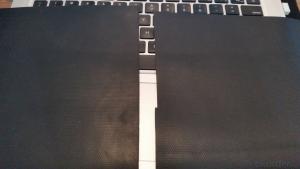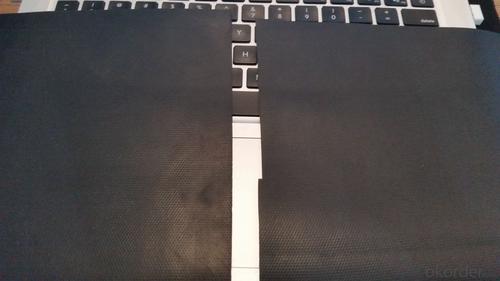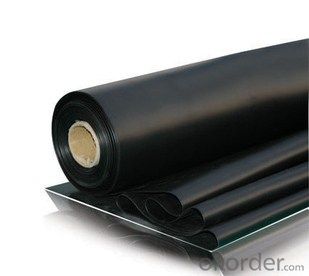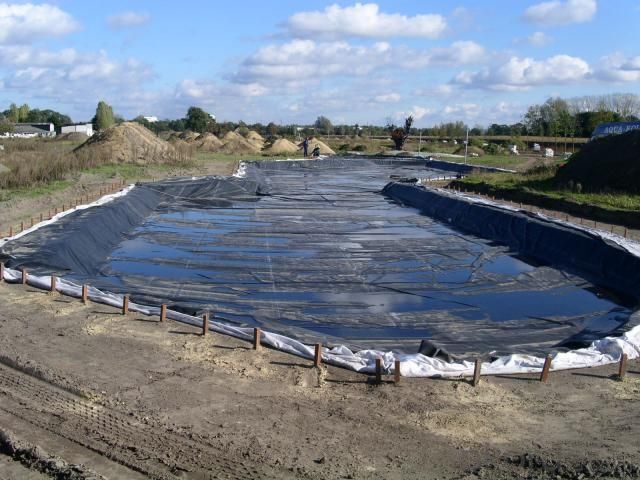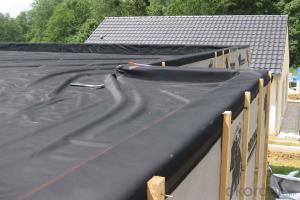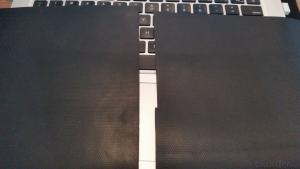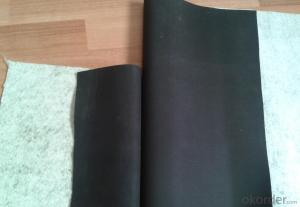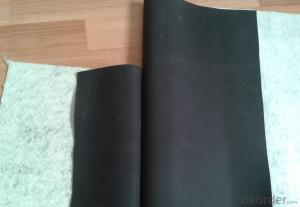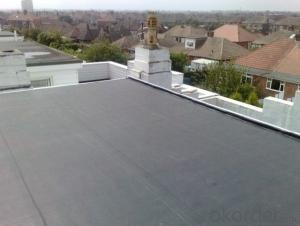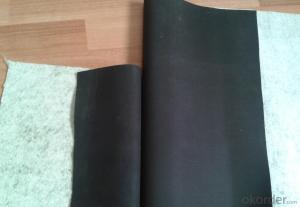EPDM Coiled Rubber Waterproof Membrane with Fleece Back
- Loading Port:
- Shanghai
- Payment Terms:
- TT OR LC
- Min Order Qty:
- 20000 m²
- Supply Capability:
- 5000000 m²/month
OKorder Service Pledge
OKorder Financial Service
You Might Also Like
EPDM Coiled Rubber Waterproof Membrane with Fleece Back
Description Of EPDM Coiled Rubber Waterproof Membrane with Fleece Back:
This waterproof coiled material is of high elasticity with best performance among high polumer
waterproof coiled material in the world.It is also the most typical one in the world.Waterproof coiled material made of ternary ethylene-propylene rubber is produced withthe use of the most advanced contiuous extrusion and vulcanization technology and related equipments which are specially designed for production of such product.It is good in compactness,without bubble and performance difference in length and breadth,perfomances reach or exceedthe demands of GB18173.1-2000 standard.
Main Features of EPDM Coiled Rubber Waterproof Membrane with Fleece Back:
A.Polyester based SBS Modified Bitumen Waterproofing Membrane
a. Strong impermeability
b. High tensile strength, elongation, ability to adapt the grassroots shrinkage deformation and cracking
c. Puncture-resistant, broken resistant, tear-resistant
d. The corrosion resistance, resistance to mildew, weathering good
e. Construction convenient, hot-melt can be operated Four Seasons Construction, reliable joints
B. Fiberglass based SBS Modified Bitumen Waterproofing Membrane
a. High tensile strength, stability of a good size
b. High Temperature good performance
c. Damage resistance, corrosion resistance, resistance to mildew, weathering good performance
d. Good construction performance, reliable joints.
Specifications of EPDM Coiled Rubber Waterproof Membrane with Fleece Back:
| Material | EPDM Rubber |
| Size | 1.2m (width)*20m (length) or customized, weldable type 2.05m or 4m width |
| Thick | 1.2mm, 1.5mm, 2.0mm |
| Type | Vulcanized & Weldable |
| Pattern | Non-reinforced (homogeneous) |
| Certificate | ISO9001/14001 |
Applications of EPDM Coiled Rubber Waterproof Membrane with Fleece Back:
1. Roofs, Basement, Toilet
2. Industrial and civil building waterproofing
3. Geo-synthetic liner for swimming pool, channels, irrigation system
4. Especially suit for projects with high requirements in durability, anti-corrosion and deformation
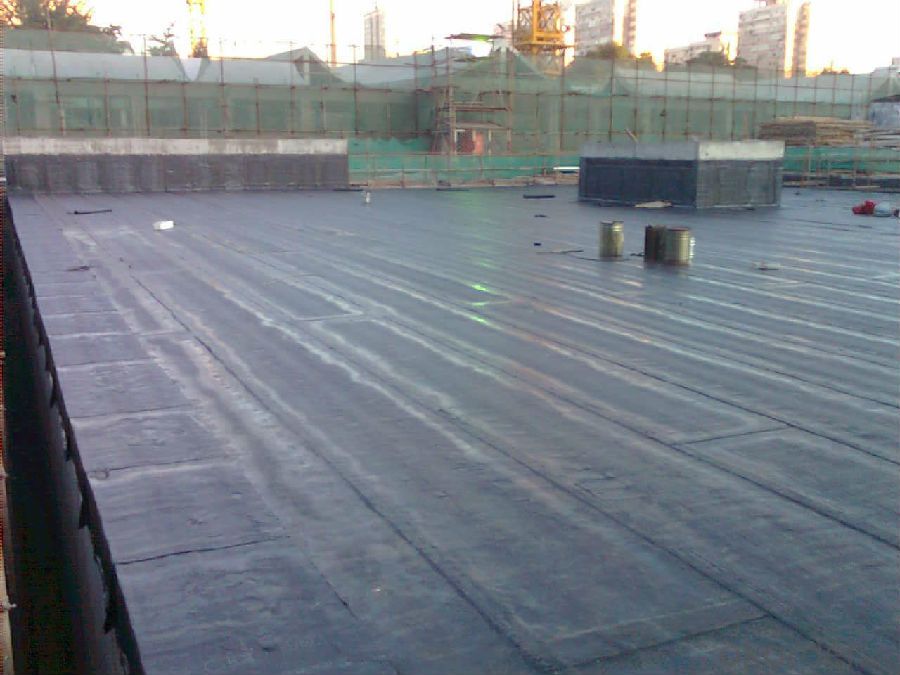
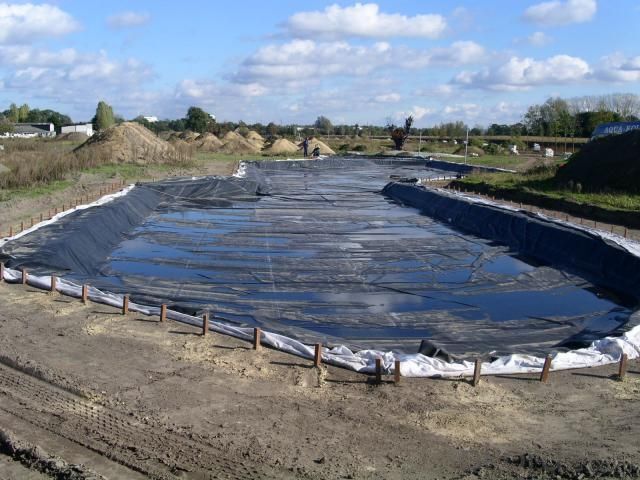

IMages of EPDM Coiled Rubber Waterproof Membrane with Fleece Back:




FAQ of EPDM Coiled Rubber Waterproof Membrane with Fleece Back:
1. What are we supplying?
We are specialized in producing Colorful Asphalt Roof Shingle, SBS/APP modified bitumen waterproof membrane, Self adhesive bitumen waterproof membrane, PVC waterproofing membrane, EPDM rubber roofing membrane, Single Component Polyurethane Waterproof Coating, and Spray Polyurea Waterproof Coating
.
2. How Many years experience do we have?
We have been exported to more than 20 countries in the past 15 years.
3. How long do we usually reply your request?
We always reply our customer within 24 hours.
- Q: Can a waterproofing membrane be used on parking garages?
- Indeed, utilizing a waterproofing membrane is highly recommended for parking garages to safeguard the structure against water damage. Parking garages are exposed to varying weather conditions, including rain, snow, and ice, which can lead to water infiltration through cracks, joints, or porous concrete. This infiltration can result in corrosion of reinforcing steel, degradation of concrete, and compromise the overall integrity of the structure. A waterproofing membrane serves as a specialized barrier system designed explicitly to impede water penetration and shield the underlying structure. Typically composed of materials like modified bitumen, PVC, or liquid applied coatings, the flexible membrane is applied to the surface of the parking garage, delivering a seamless and resilient waterproof barrier. Using a waterproofing membrane for parking garages offers numerous advantages. Firstly, it significantly prolongs the lifespan of the structure by shielding it from water-induced deterioration. Secondly, it upholds the structural integrity of the garage by preventing reinforcing steel corrosion, which can gradually weaken the structure. Furthermore, a waterproofing membrane maintains a dry and secure environment within the parking garage, thereby reducing the risk of slip and fall accidents. It is crucial to consider the specific requirements and conditions of the parking garage when selecting the appropriate waterproofing membrane. Factors such as the type of parking garage (underground, above ground, or rooftop), traffic volume, presence of vehicular fluids, and climate should all be taken into account when choosing the suitable waterproofing membrane system. In conclusion, to safeguard parking garages from water damage, extend their lifespan, and ensure a safe environment for users, the use of a waterproofing membrane is both viable and essential.
- Q: Can waterproofing membranes be used on outdoor patios?
- Yes, waterproofing membranes can be used on outdoor patios. They are an effective way to protect the patio from water damage and can help to prevent leaks and moisture penetration. Waterproofing membranes create a barrier between the patio surface and water, keeping it dry and extending its lifespan.
- Q: Can a waterproofing membrane be used for a green roof system?
- Yes, a waterproofing membrane can be used for a green roof system. In fact, a high-quality waterproofing membrane is an essential component of a green roof system. Green roofs are designed to support the growth of vegetation and require a durable and reliable waterproofing barrier to prevent water leakage and protect the underlying structure from moisture damage. A waterproofing membrane acts as a protective layer, effectively sealing the roof and preventing water from penetrating into the building. Additionally, the membrane helps to retain water within the green roof system, ensuring that the plants receive an adequate water supply. Therefore, integrating a waterproofing membrane into a green roof system is crucial for its success and longevity.
- Q: Can a waterproofing membrane be used on brick walls?
- Yes, a waterproofing membrane can be used on brick walls. It helps to prevent water penetration and protects the bricks from moisture damage.
- Q: How does a waterproofing membrane adhere to the surface?
- A combination of mechanical and chemical bonding is responsible for the adherence of a waterproofing membrane to a surface. Typically, a specialized adhesive or primer is used to apply the membrane, aiding in the creation of a robust bond between the membrane and the surface. Mechanical bonding occurs when the adhesive or primer penetrates the surface's pores, establishing a physical bond between the membrane and the substrate. This guarantees a secure attachment, enabling the membrane to withstand various forces. Chemical bonding is also crucial in the adhesion process. The adhesive or primer contains chemicals that react with the surface, resulting in chemical bonds with the membrane. This chemical reaction produces a durable and long-lasting bond capable of withstanding environmental factors like temperature changes, moisture, and UV exposure. Moreover, the composition of the waterproofing membrane itself contributes to its adhesion. Many membranes are made of materials with inherent adhesive properties, such as bitumen or rubberized asphalt. These materials possess natural tackiness, allowing them to adhere to the surface without the need for additional adhesives or primers. In summary, the adherence of a waterproofing membrane to a surface relies on a combination of mechanical and chemical bonding facilitated by specialized adhesives or primers. This ensures a strong and durable bond, effectively safeguarding the surface against water damage.
- Q: Pvc waterproof membrane of the scope of application
- 3, with good weldability, seam hot air welding and the substrate into one; 4, with good water vapor diffusion, condensate easy to release; 5, low temperature flexibility is good, to adapt to the environmental temperature difference is good;
- Q: Can a waterproofing membrane be used in interior or exterior applications?
- A waterproofing membrane can be utilized in both interior and exterior scenarios. When used indoors, such as in basements or bathrooms, the membrane can be applied to walls or floors to effectively prevent water or moisture infiltration. This safeguard shields the underlying structure from potential harm caused by water intrusion. For exterior applications, the waterproofing membrane can be employed on the outer walls or foundations of a building to effectively repel water. This becomes particularly crucial in regions with heavy rainfall or high water tables. By creating a barrier against water, the membrane effectively maintains a dry and water-free interior environment for the building. In conclusion, the utilization of a waterproofing membrane in both interior and exterior contexts is absolutely necessary in order to ensure the longevity and durability of a structure by effectively safeguarding it against water-related issues.
- Q: Can waterproofing membranes be used on concrete slabs?
- Concrete slabs can indeed utilize waterproofing membranes. In fact, it is a widely adopted technique to shield concrete slabs from water harm. The purpose of waterproofing membranes is to establish a barrier that halts water infiltration into the concrete surface. This becomes particularly crucial for regions susceptible to moisture, like basements, balconies, or swimming pools. Through the application of a waterproofing membrane, the concrete slab effectively safeguards itself against water infiltration, which might otherwise trigger cracks, erosion, or the growth of mold. Moreover, these membranes have the added benefit of bolstering the overall longevity and durability of the concrete slab.
- Q: Are waterproofing membranes suitable for balconies and terraces?
- Yes, waterproofing membranes are suitable for balconies and terraces. These membranes are specifically designed to provide a protective barrier against water and moisture, preventing any potential damage to the structure of the balcony or terrace. Waterproofing membranes are typically made of materials such as rubber, bitumen, or PVC, which are highly resistant to water penetration. They are applied as a liquid, sheet, or spray, creating a seamless layer that covers the entire surface of the balcony or terrace. This ensures that no water can seep through and cause any structural issues, such as cracks, leaks, or deterioration. Additionally, waterproofing membranes can also protect against other forms of damage, such as mold growth or corrosion. Overall, using waterproofing membranes on balconies and terraces is an effective and recommended solution for maintaining their longevity and structural integrity.
- Q: How do waterproofing membranes adhere to surfaces?
- Waterproofing membranes adhere to surfaces through the use of adhesive materials, such as modified bitumen or synthetic rubber compounds, which are applied to the surface and bond with it. The adhesive properties of these membranes allow them to create a tight and seamless seal, preventing water penetration and ensuring long-lasting waterproofing protection.
Send your message to us
EPDM Coiled Rubber Waterproof Membrane with Fleece Back
- Loading Port:
- Shanghai
- Payment Terms:
- TT OR LC
- Min Order Qty:
- 20000 m²
- Supply Capability:
- 5000000 m²/month
OKorder Service Pledge
OKorder Financial Service
Similar products
Hot products
Hot Searches
Related keywords
